The jewel of Central Asia, the center of Islamic studies, and a pitstop for the likes of Genghis Khan and Marco Polo alike. Exploring magnificent Registan, stargazing in one of the oldest observatories on earth, and bribing a guard to walk up rickety stairs for the best views over the old city are but a few of the many things to do in Samarkand.
The last stop on our Uzbekistan itinerary is the spectacular city of Samarkand in southeastern Uzbekistan. Comprised of a new city – built by the Russians – and an ancient city, built between the 11th and 17th centuries so well preserved it received UNESCO classification.
We spent a glorious three days exploring the three M’s- Madrasahs, mosques, and mausoleas, gazing up at towering domes and minarets clad in exquisite blue tiles and discovering everything there is on offer in Samarkand. Things to do are plentiful, culture is abundant, and local fare is fragrant.
This Samarkand guide takes you through all the practical details for planning your visit, describes the various things to do, and will hopefully encourage you to add not only Samarkand but also Khiva and Bukhara to your bucket list.
Please note: This post contains affiliate links, meaning I may earn a commission if you make a purchase by clicking a link (at no extra cost to you). Learn more.
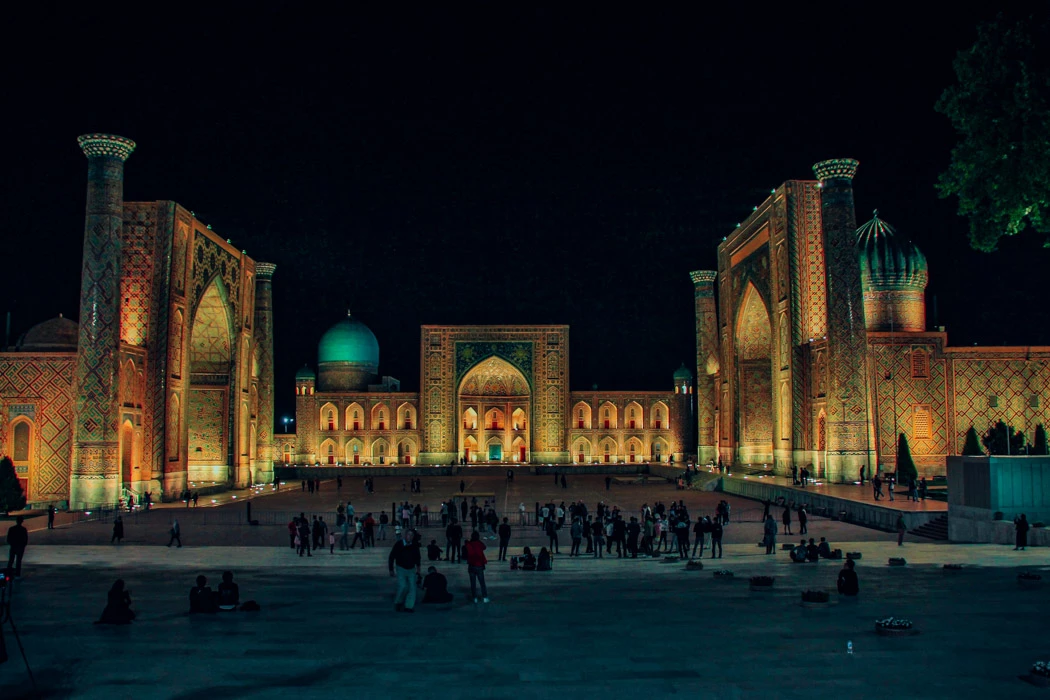
Visiting Samarkand Travel Essentials
WHERE TO STAY
- Best Location: Hotel Minor
- Value for Money: Hotel Rahmon
- Best Views: Bibikhanum Hotel
- Family Run: Platan Boutique Hotel
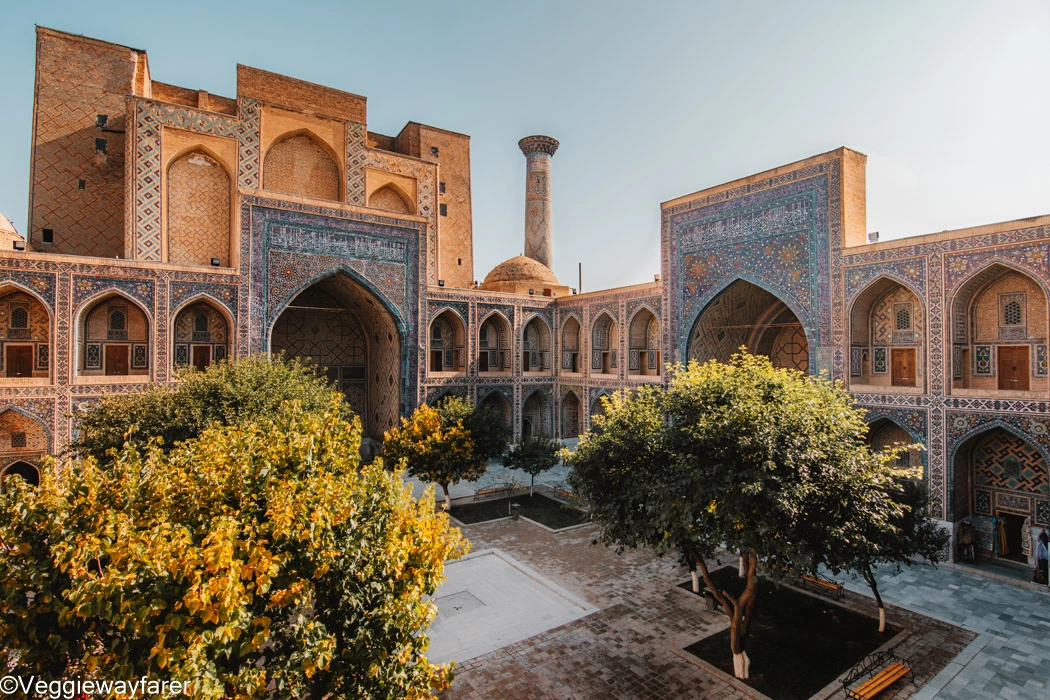
Uzbekistan tours including Samarkand
Traveling through Uzbekistan without an organized tour is relatively easy. Public transportation is efficient, locals are eager to help, and accommodations are a dime a dozen. Therefore I highly recommend exploring Uzbekistan without a guided tour. If however, that is of no interest to you, have a look at the following Uzbekistan tours that include Samarkand.
8 Days Uzbekistan Tour: Includes a visit to Tashkent, Khiva, Bukhara, and Samarkand with a guide. Also has the option of canceling free of charge 7 days prior to departure
7 days Golden Ring Uzbekistan Tour: Includes visits to Tashkent, Khiva, Bukhara
and Samarkand with a guide as well as the train tickets and flights between Tashkent and Khiva.
Practical details for visiting Samarkand
All prices indicated in this Samarkand travel guide are in Uzbekistani som (UZS) and reflect the prices of travel in 2022.
To navigate around Samarkand download the maps.me which is more reliable than Google Maps in Uzbekistan and works perfectly offline too.
How many days to visit Samarkand
There is a lot to see both in and around Samarkand. Two full days to explore the main highlights inside the city are an absolute must, consider adding in one extra day and taking one of the many day trips from Samarkand to explore some lesser-known places in Uzbekistan (Shakhrisabz is one of the most popular day trips).
Best time of the year for Samarkand Tourism
The best months to visit Uzbekistan are March, April, the beginning of June, and September through to halfway October. Temperatures start rising in March (13°C/ 55°F) and are pleasant until the beginning of June (34°C/ 59°F). By September the blistering sun is less warm (28°C/ 82°F) and continues to be pleasant until the middle of October.
Our trip was at the very end of October, the advantage of going at the end of the high season was that we had Samarkand virtually to ourselves. The disadvantage was the bitter cold, if you happen to visit at the same time make sure to bring along thermals and heavy socks.
How to get around Samarkand
The main Samarkand attractions are within walking distance from each other. The only exception to the rule is Shah-i-Zinda, located a good 30-minute walk from Registan. There is the option to take a local taxi, the standard rate is 4000 UZS ($0.35) to ride anywhere in Samarkand.
Getting from the station to the center of Samarkand should cost no more than 5000 ($0.44) UZS.
Never get into a taxi before you have agreed upon a price!
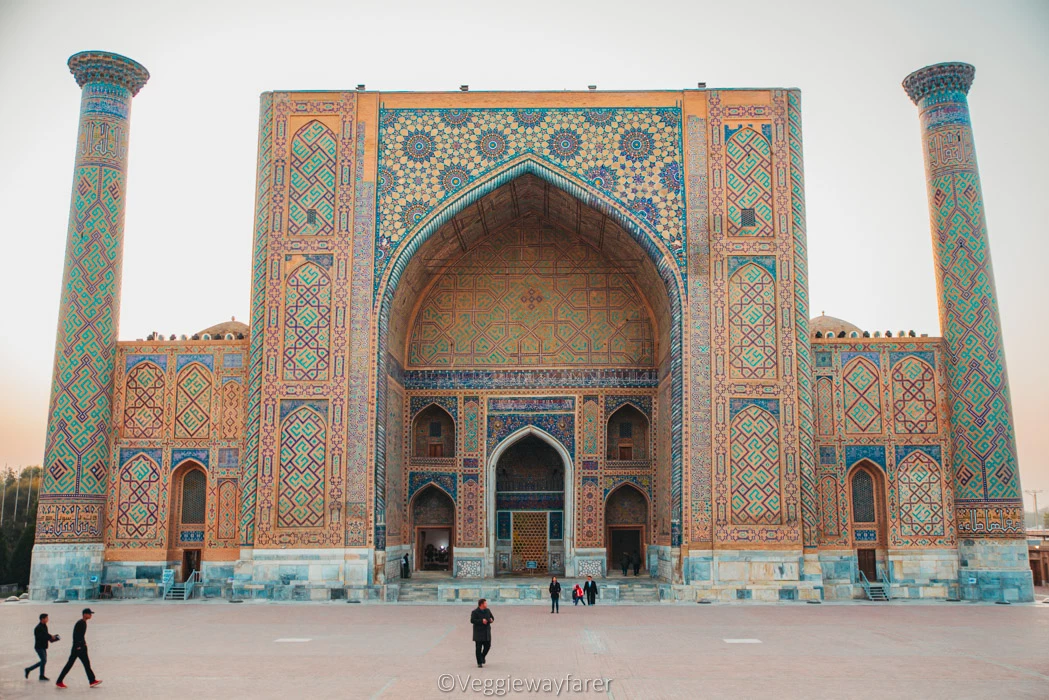
A brief history of ancient and modern Samarkand
Some say Samarkand is one of the oldest inhabited cities in Central Asia, dating as far back as the 8th century BC. With a strategic location smack between China and Europe, it prospered during Medieval times as the Silk Road flourished, attracting traders (Marco Polo), writers, and artisans as well as notorious marauders (Alexander the Great & Genghis Khan).
It was under the patronage of these various rules that the city started transforming into the jewel it is today. The infamous Emir Timur (1370-1405) – a lover of arts – attracted flocks of craftsmen to the city building many madrassahs (Islamic schools) transforming Samarkand into the most important center of Islamic studies.
His love for the arts & science was inherited by his famous grandson Ulugbek (1409-1449), to whom we owe one of the three main Madrassahs on Registan Square as well as one of the oldest observatories in all of Central Asia (the Ulugbek observatory) expanding the prestige of Samarkand into the realm of medieval sciences.
The decline of the Silk Road led to a slump in the otherwise illustrious history of Samarkand until the introduction of a railway in the late 19th century by the Russian Empire where its importance as a trading post was once again reaffirmed.
Modern Samarkand
The city as can be seen today bears the traces of a long and lustrous history. Ancient Samarkand has been left virtually untouched. The soaring, tile-clad madrassahs and mausoleum have been lovingly renovated and continue to offer refuge to weary travelers on a journey to Samarkand, much like they did 600 years ago.
Modern-day Samarkand lies to the West of ancient Samarkand and is where the majority of locals have their homes. With over half a million inhabitants, Samarkand is the third-largest city in Uzbekistan. It is considerably more busy than its fellow Silk Route trading outposts Bukhara and Khiva.
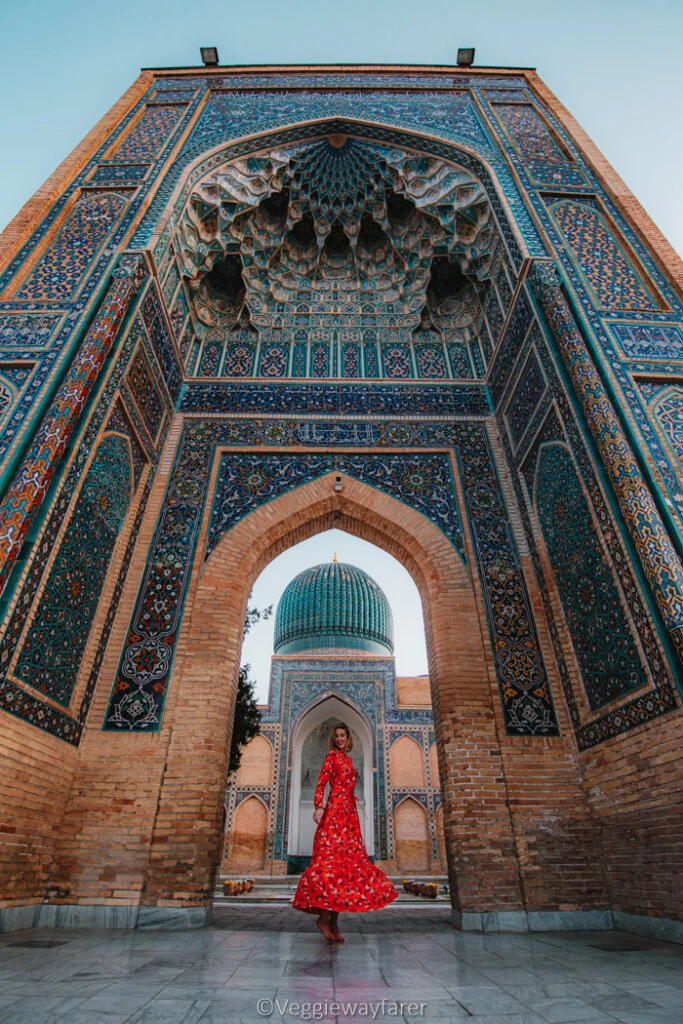

Samarkand itinerary overview
This sample itinerary for Samarkand entails a pretty packed 2-days of exploring. If you are lucky enough to visit Samarkand for 3 or even 4 days consider adding in a day trip to explore the neighboring Bukhara or Shahrisabz.
Day One: Registan, Gur-I-Amir Mausoleum, Old Town Samarkand, Uzbekistan Wine tasting
Day Two: Shah-I-Zinda, Ulugh Beg Observatory, Siab Bazaar, Bibi Khanym Mosque, Registan at night
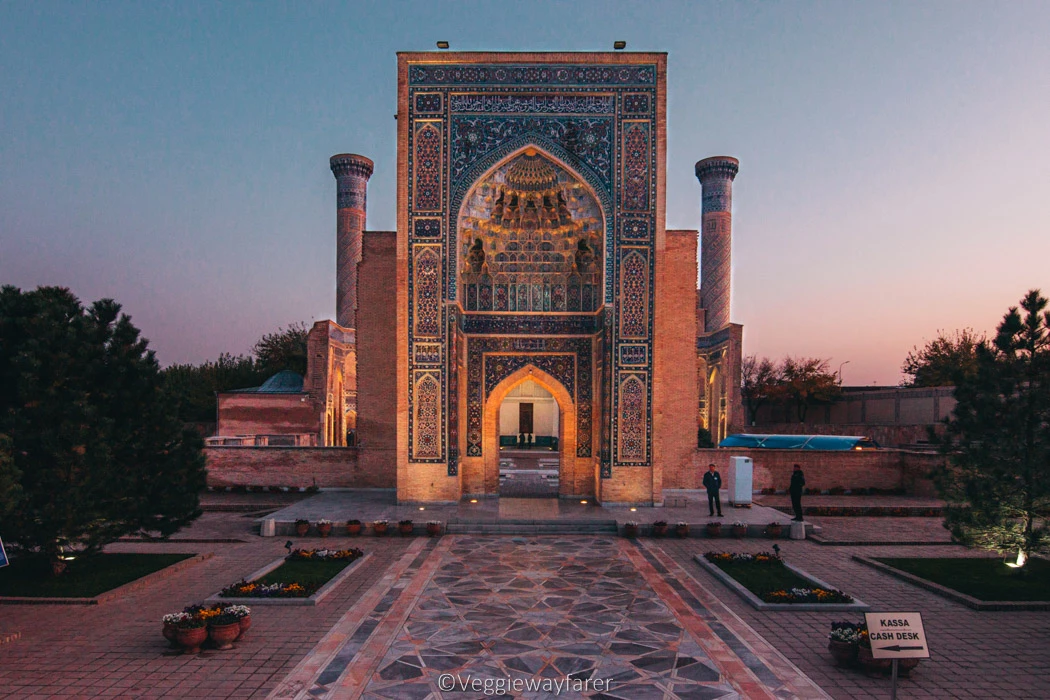
13 Things to do in Samarkand
There are plenty of things to do and see in Samarkand. The sheer amount of impressive mosques, awe-inspiring madrasahs, soaring minarets & domes clad in glazed tiles embellished with arabesque swirls will keep both eyes and soul entertained for any adventurous traveler on a journey to Samarkand.
Tip: Samarkand has a dense regional history. Investing in a knowledgeable local guide is a great way to uncover the many aspects of the city and learn about the local culture.
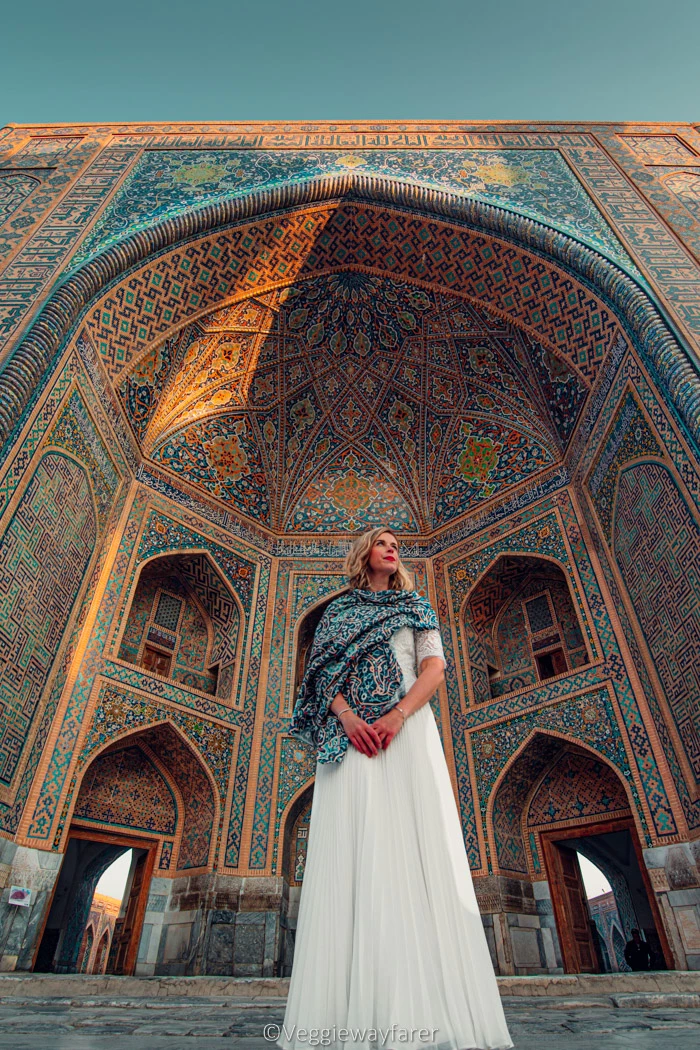

1. Explore every nook and cranny of majestic Registan
The Registan ensemble is the undisputed highlight of any trip to Samarkand. The square is adorned by three spellbinding madrasahs, from left to right: Ulugh Beg Madrasah (15th century), Tilya-Kori Madrasah (17th century), and Sher-Dor Madrasah (17th century).
This arsenal of majestic buildings was devoted to prayer and learning. Typically they served the function of both campus and dorm for students and professors of Islamic studies, which explains the presence of the many different little alcoves (previously classrooms and dorms now souvenir shops) inside the courtyards of all three madrasahs.
Tickets for Registan are bought at the ticket booth in front of the square, to be paid in cash only. They include the entrance to the three madrasahs and are valid for one day. If you are planning on coming back to Registan a few times during the day, make sure to tell the guard to ensure he does not rip up the ticket completely.
Opening Hours Registan: Monday to Sunday 08.00 am – 7.00 pm
Entrance Fee Registan: 40,000 UZS ($4)
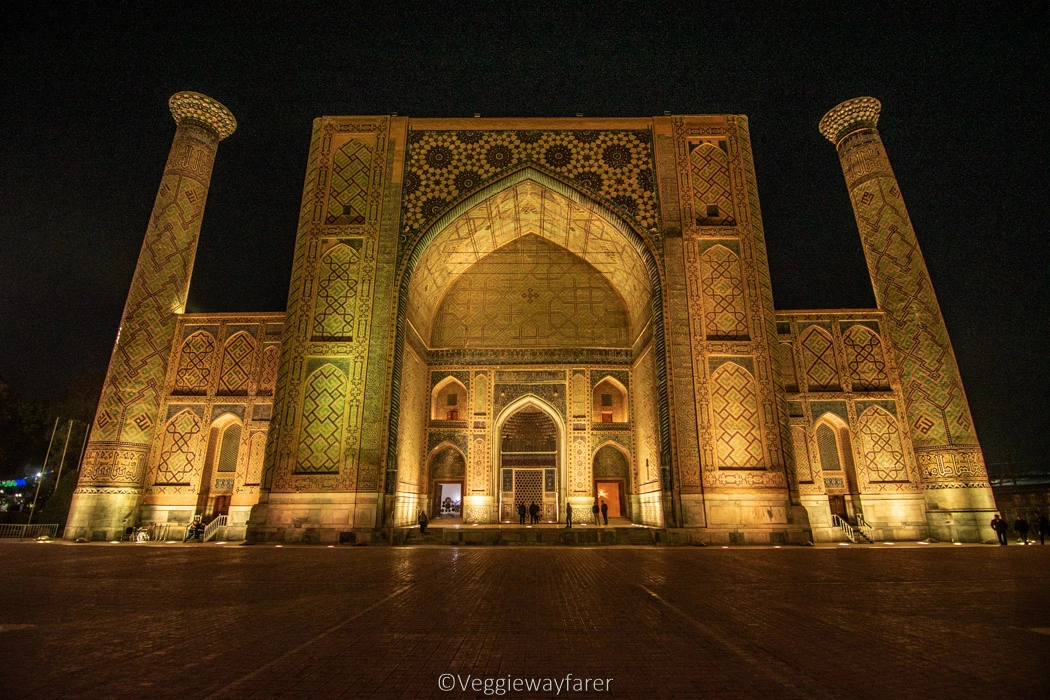
2. Go stargazing at the Ulugh Beg Madrasah
The original madrasah was built by the grandson of the famous Emir Timur. It took a mere 3 years to build (1417 to 1420) and despite being the oldest of the three it is the best preserved. Take a closer look at the portal, the stars adorning the façade are a wink to Ulugh Beg’s adoration for the sciences, astronomy in particular.
Step into the beautiful courtyard, filled with little souvenir stores selling colorful suzanis and traditional handicrafts. Walk to the end of the courtyard and turn left towards a small staircase leading up to the second floor of the Madrasah.
Grab a tea and a traditional biscuit in the small cafe at the top of the stairs (cash payment only) and take in the impressive architecture while honing your skills in people-watching or simply rest your feet after a day of Samarkand sightseeing.
Opening Hours: Monday to Sunday 08.00 am – 7.00 pm
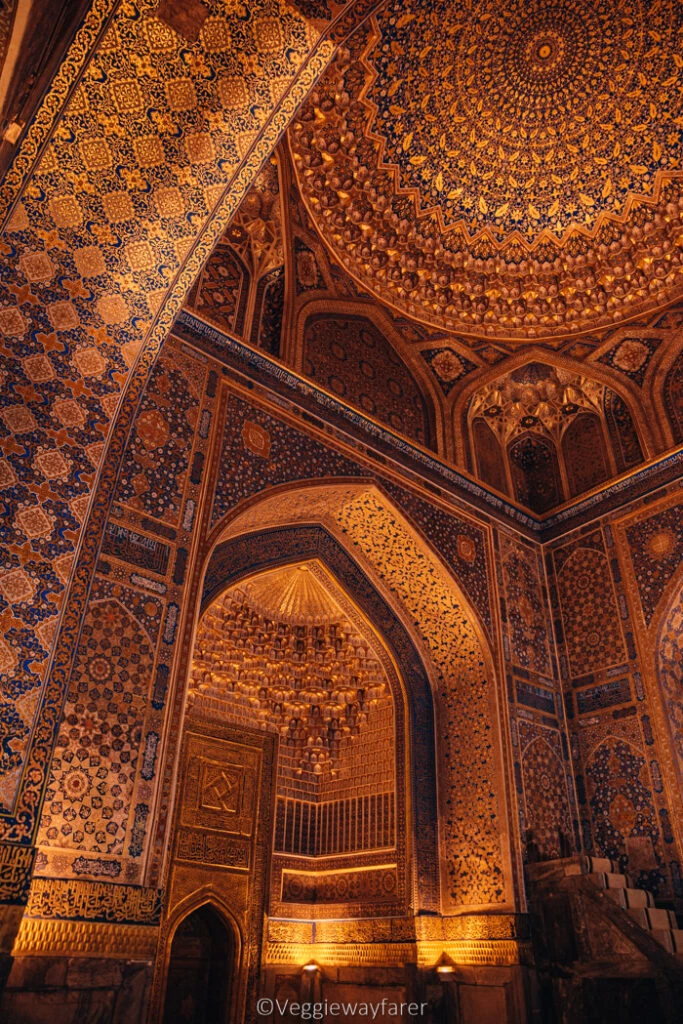

3. Visit the gold-leaf mosque inside the Tilla-Kari Madrasah
As you meander out of the Ulugek Madrasah, turn left and head towards the Tilla-Kari Madrasah. The site originally housed a Caravanserai (a traditional hotel for travelers) before making way for the Tilla-Kari Madrasah (17th century), the last of the three illustrious Madrasahs to be built on the Registan Square.
Tilla Kari means ‘gold-covered’ and refers to the lavishly gold-leaf adorned domed chamber of the mosque inside a true testimony to the wealth of Samarkand in the 17th century. Step over the threshold and into a beautiful tree-lined courtyard, turn left towards Tilla Kari Mosque and be prepared for one of the most lavish places to visit in Samarkand.
The chamber is richly adorned by blue-glazed mosaic tiles (produced in the city of Kashan, Iran), marble mihrabs, and intricately carved golden stucco. Interestingly enough the central chamber has a domed effect, this is a mere tromp l’oeil as the roof is flat!
Opening Hours: Wed – Mon 8.00 am – 11.00 pm, Tues 8.00 am – 6.00 pm
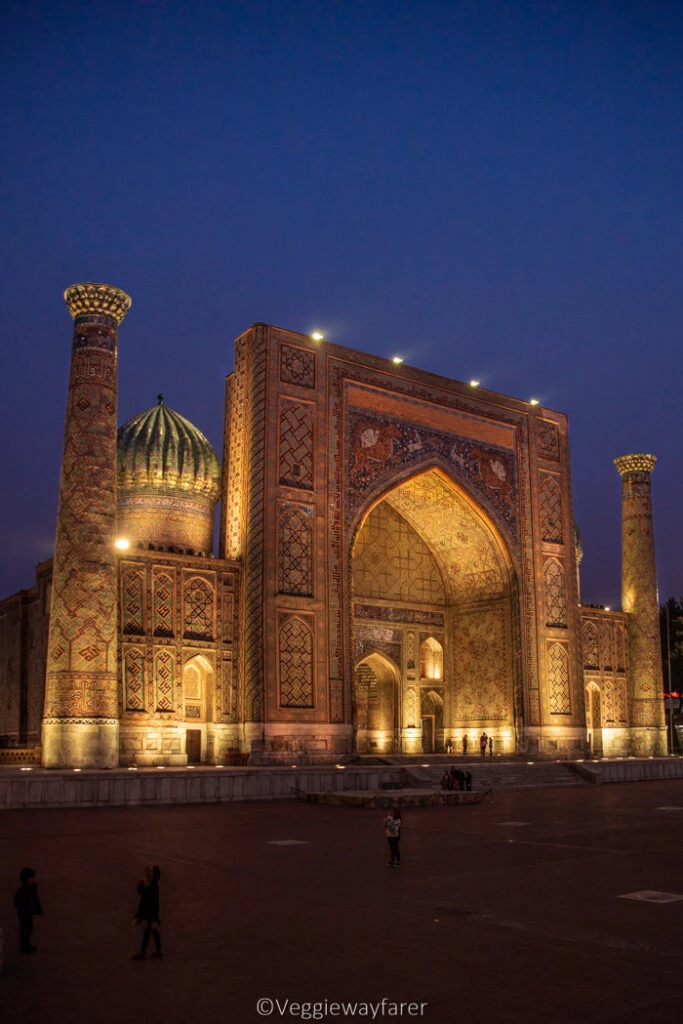

4. Spot the lions in the Sher Dor Madrasahs
That brings us to the third and final Madrasah on the right-hand side of Registan Square. Before heading inside, take a minute to look at the façade can you spot the various animals and the Zoroastrian-suns. Both are highly unusual in traditional Islamic architecture of the day.
While still an impressive feat of architecture, this 17th-century Madrasah is – in my personal opinion – the lesser starlet of the three.
Opening Hours: Monday to Sunday 08.00 am – 8.00 pm
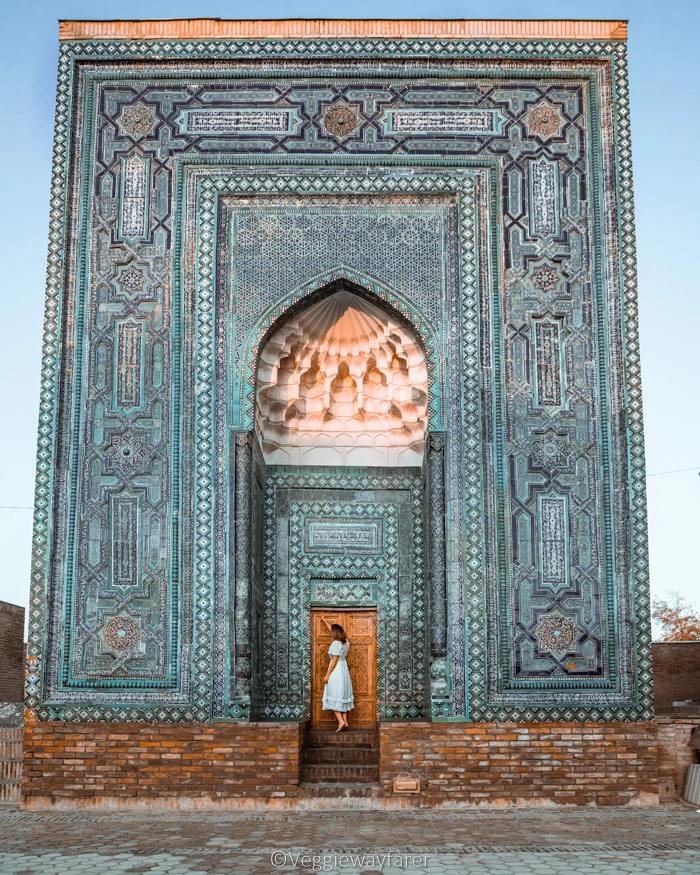

5. Spend hours in the world’s most picturesque cemetery: Shah-i-Zinda
Just northeast of Registan on the outskirts of the city of Samarkand lies the sumptuous avenue of mausoleums that forms the Shah-i-Zinda complex. While the idea of visiting a cemetery might feel a little morbid, the fact it contains the most spellbinding and lavish tilework in the Muslim world convinces you otherwise.
The oldest buildings in Shah-i-Zinda date back to the 11-12th centuries while the largest portion was built in the 14-15th centuries. Inside you will find the holy shrine of Qusam ibn-Abbas (known as “Tomb of the Living King” or Shah-i-Zinda), who is said to have brought Islam to the region in the 7th century AD. Family, clergymen, and aristocracy from the Timur era were also enshrined on this avenue of Mausoleums.
Shah-i-Zinda is an important site of pilgrimage, please treat it as such by ensuring an appropriate style of attire (knees covered, modest dress) and respectful attitude when entering one of the most beautiful places to see in Samarkand.
Opening Hours Shah-I-Zinda: every day 9:00 am – 7:00 pm
Entrance Fee Shah-I-Zinda: 45,150 UZS ($4)
Dresscode: Modest (cover knees and elbows)
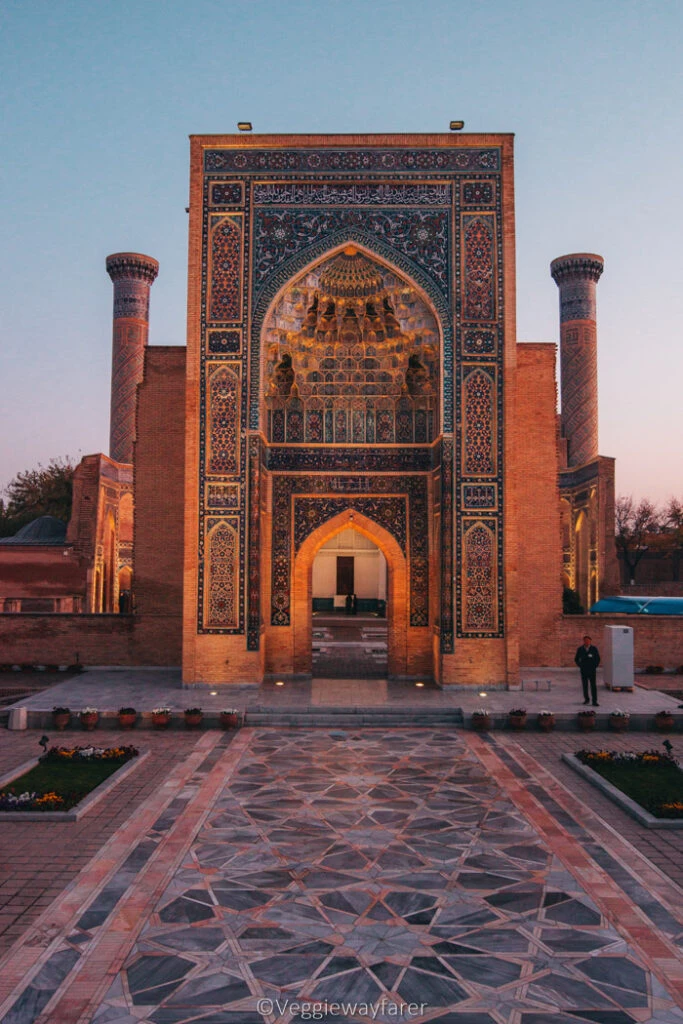

6. Marvel at the Gur-e-Amir Mausoleum
The enthralling 14th-century Gur-e-Amir Mausoleum is famous for its relative simplicity, at least in comparison with some of the other more opulent places to visit in Samarkand.
Travelers are often surprised to find the famous Emir Timur himself was enshrined within its very walls, though legend has it that was in fact more of an accident than the original plan. Timur died suddenly of pneumonia while out warmongering in Kazakhstan.
The roads to his – far more grand – planned mausoleum in Shakhrisabz were frozen over and so he was laid to rest in his beloved Samarkand instead. Emir Timur shares the mausoleum with his two sons and two grandsons, amongst whom the famous Ulugh Beg. All interred within the walls of this most sacred Samarkand sight.
Make sure to visit the lavish interior of the mausoleum, festooned with hundreds of tiles and gold leaf – a stark contrast to the more austere exterior. We visited just before closing, upon leaving dusk started settling in around us and the lights were turned on basking the mausoleum in a soft glow and adding to the overall allure.
Gur-e-Amir is a sacred place and continues to be a location for worship. Make sure to dress modestly when entering the shrine.
Opening Hours Gur-e-Amir Mausoleum: every day 9:00 am – 7:00 pm
Entrance Fee Gur-e-Amir Mausoleum: 25,000 UZS ($2.20) good for 3 days
Dress code: Modest (cover knees and elbows)
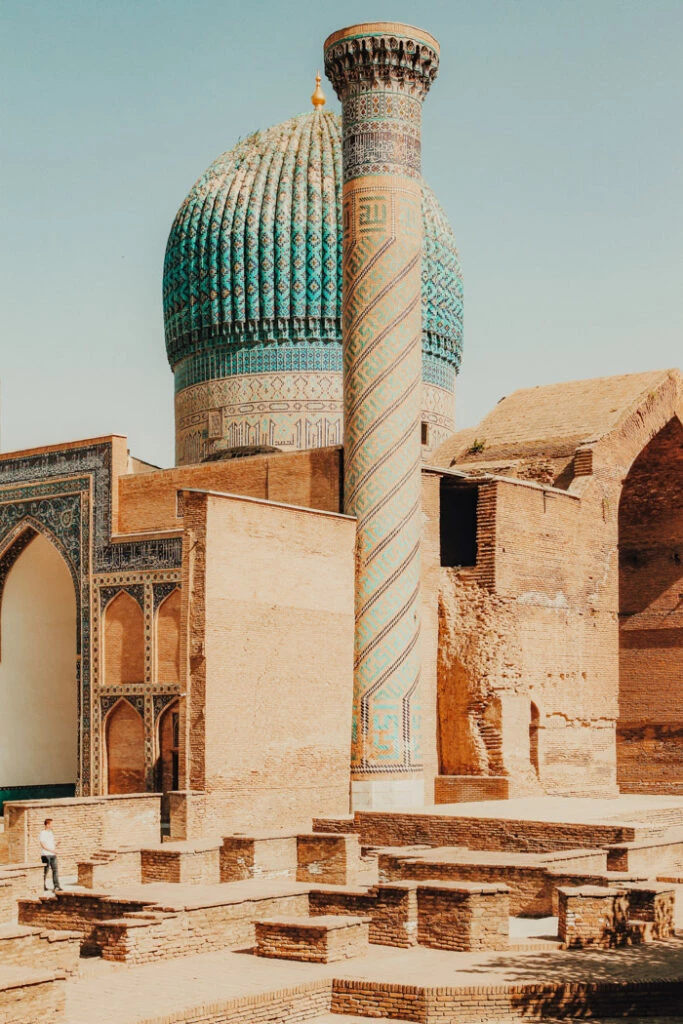

7. Bibi Khanym Mosque
The 14th-century Bibi Khanym Mosque is another architectural feat commissioned during the reign of Emir Timur. Entirely financed by the spoils of Timur’s many raids and built for his favorite Chinese wife, Bibi Khanym. It is said to have been one of the largest and finest mosques in the entire Islamic world, with a capacity to hold 10.000 worshippers.
The Emir himself personally oversaw the works for these mosques, tearing down the first version of the entrance gate (Iwan) that was constructed in favor of a more grand model. Reportedly tossing meat and gold coins to the laborers to incite productivity.
Most of the buildings in ancient Samarkand built during the Timur and Ulugbek reigns have withstood the passing of time remarkably well. Alas, this was not the case for the Bibi Khanym Mosque. Spurred on by an overzealous Timur, the Mosque was built to awe and exude power with its sheer size. It proved however to be no match for the 1897 earthquake that dealt a devastating blow to the structure.
Opening Hours Bibi Khanym Mosque: Every day 08:00 am to 07:00 pm
Entrance Fee Bibi Khanym Mosque: 55,000 UZS ($4.87)
Dresscode: Modest (cover knees and elbows)

8. Try your hand at Uzbekistan Wine
With a viticulture sector dating back to ancient Roman times, Uzbekistan has a long tradition of making wine. In fact, growing the viticulture sector has been a national priority since 2006 and the amount of vineyards and types of grapes cultivated is growing year on year.
Why not try out some of the country’s most delicious wines. A two-hour wine tasting tour at the Khovrenko Winery followed by a visit to the Samarkand Museum of Winemaking should prove to be a great initiation into the world of Uzbekistani Wine.
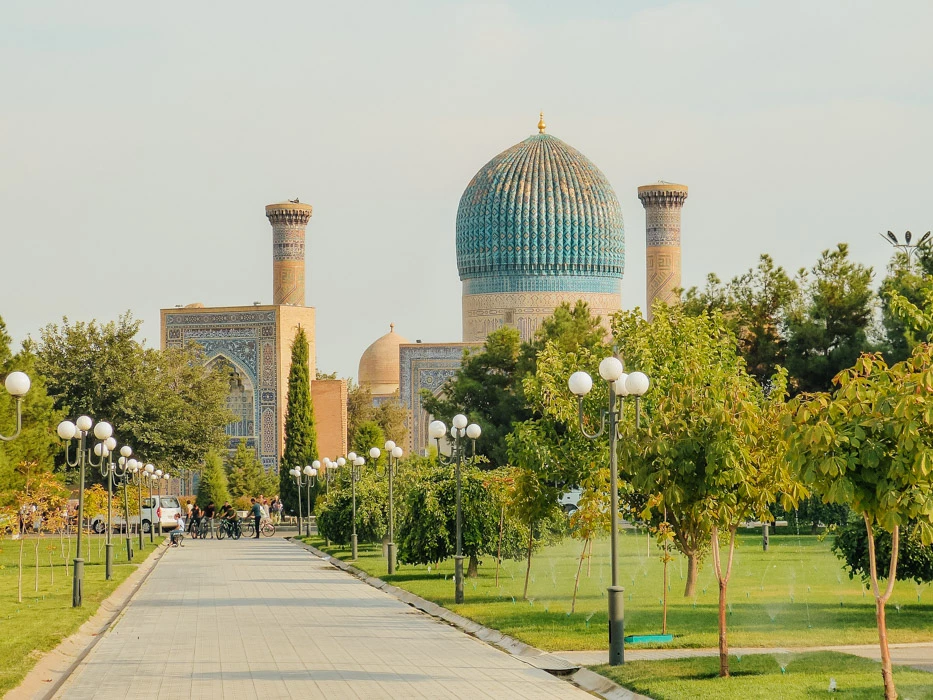
9. Get lost in the little alleyways of ancient Samarkand
The city plan of old town Samarkand dates back to the Middle Ages and has stayed virtually in-fact. Wander the narrow alleys snaking around the fabled monuments, intersected by hawkers selling an eclectic mixture of artisanal goods and overpriced tchotchkes.
Grab a cup of kuk-choy (green tea) or kora-choy ( black tea) at the folkloric Bibikhanum Teahouse and watch locals – oftentimes dressed in colorful floral robes and headscarves for women or felt embroidered hats for men – go about their business.
Samarkand does tend to get a fair amount of tourists. Those quaint alleys in Old Town can get oppressive both due to the heat (summer) and the sheer volume of people. My favorite moment to explore was early in the morning, sharing the streets with a handful of early bird locals setting up their stalls for the day.
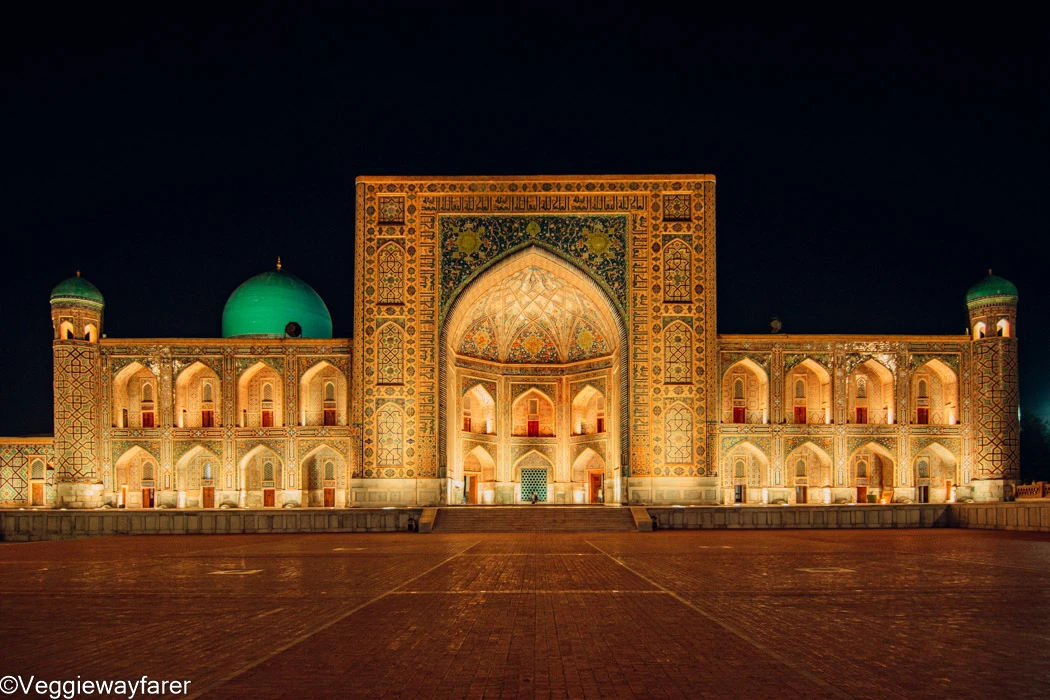
10. Check out Registan at night
If you thought Registan was impressive during the day, wait until it is fully lit up at night. The sweeping aiwans, glazed domes, and minarets lit up in the soft glow a stark contrast against the starry night sky look like they belong in an Aladdin movie.
The Registan square is closed off by a fence at 07.00 PM. During certain months of the year, there is an impressive light show, projecting the history of Samarkand, during this time the fence in front of the square is opened! Admission is included in the day ticket of the Registan complex. From what I read the dates are not fixed and it is best to check with your local guesthouse when the show is held.
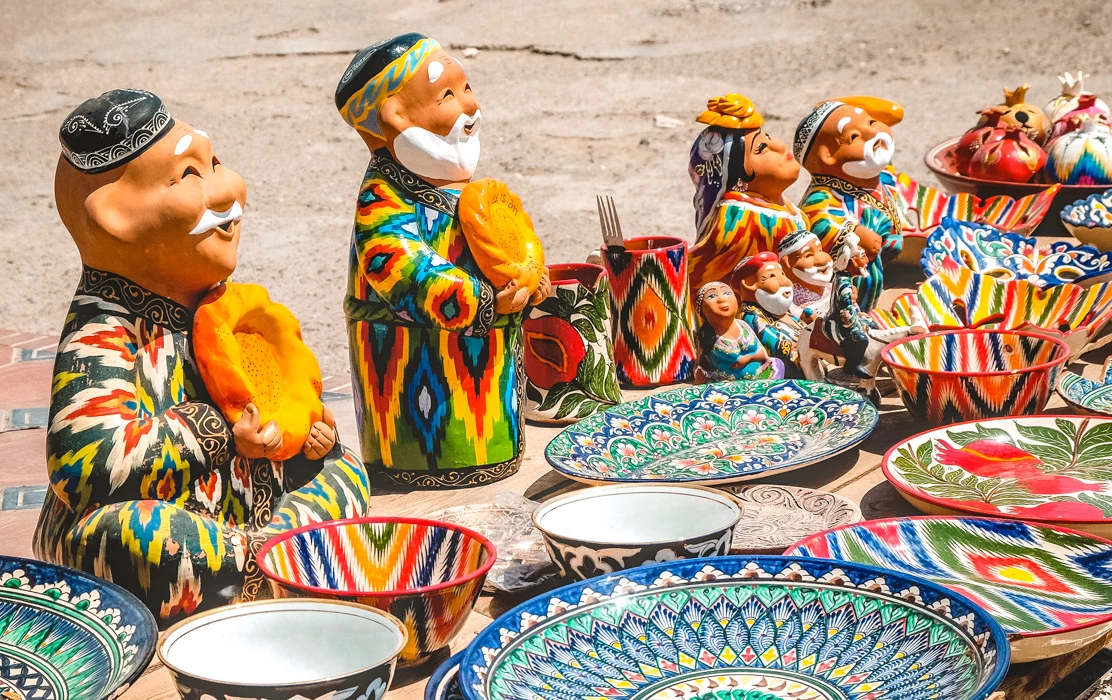
11. Go souvenir shopping in the Siab Bazaar
There is no better way to connect with local culture than to go shopping in one of the markets and there is no better place than the Siab Bazaar in Samarkand. Things to do include trying the various local snacks and shopping for local souvenirs to take back home.
Tip: Remember to always bargain when shopping in Uzbekistan. Aim to pay 75% of the initial asking price.
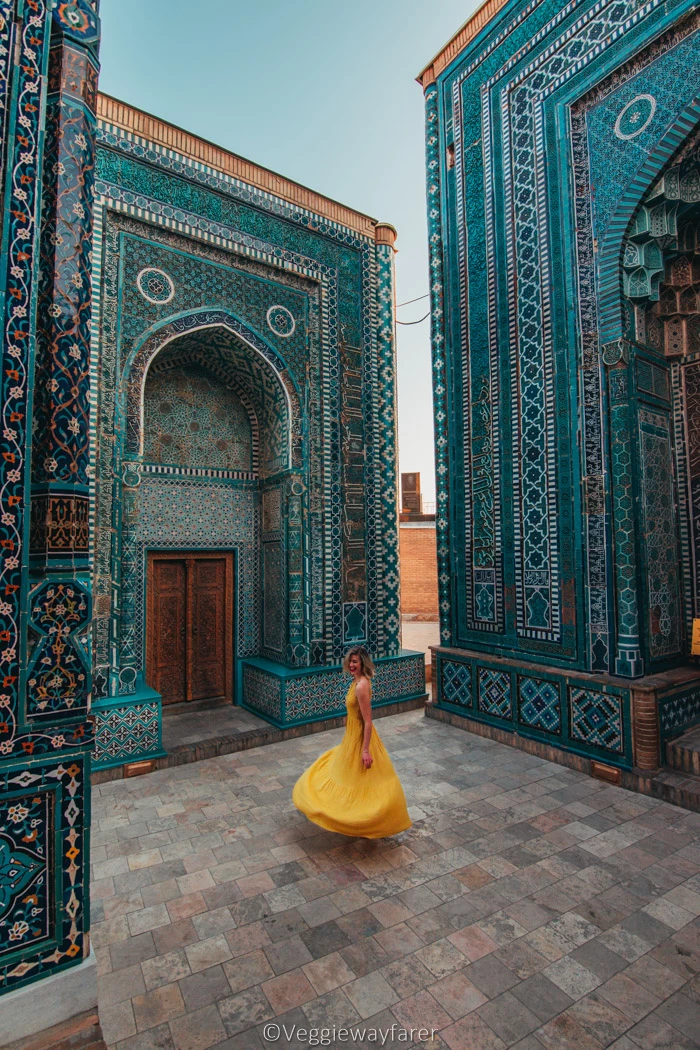

12. Invest in a locally run tour
Tours by locals is a platform where locals from all over the world can offer truly locally run tours. For Samarkand, they offer a local cooking class in one of the smaller villages 15 kilometers outside of Samarkand ( in Eshim Oksok ).
This 4-hour cooking class teaches you to make traditional Uzbekistani Non (bread) as well as the famous rice dish, the nation’s favorite – Plov and gives you a crash course in Uzbekistani hospitality. Hotel pick-up and drop-off are included.
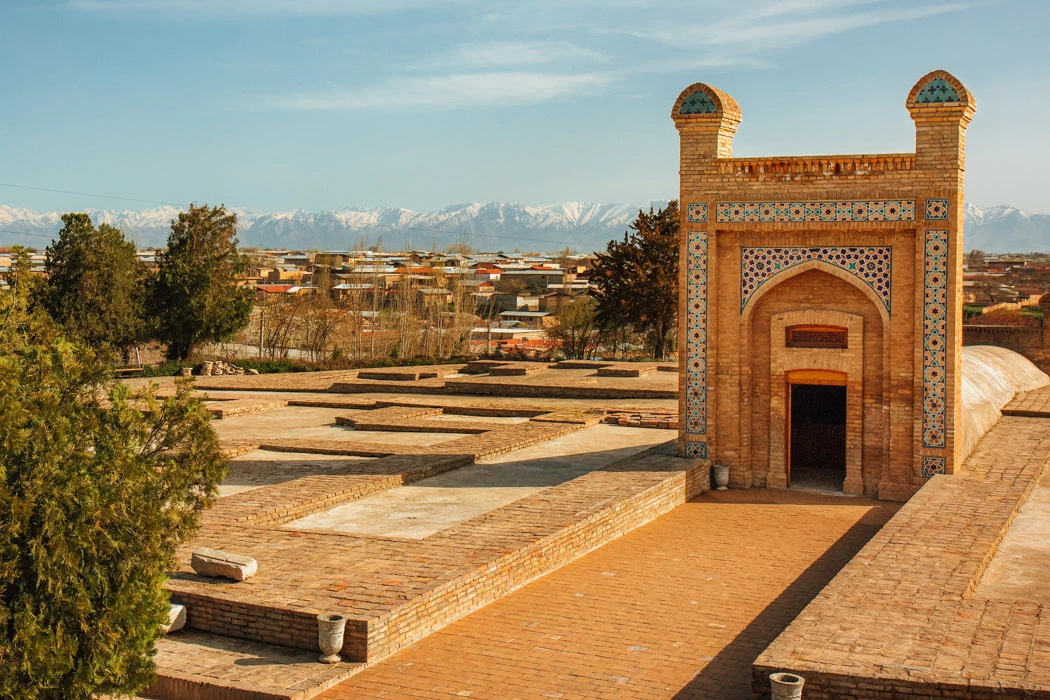
13. Visit the Ulugh Beg Observatory
Aside from the prettiest madrassah in Samarkand, the legacy of Ulugh Beg also includes one of the oldest observatories in Central Asia. The remains of this 15th-century observatory are but a small part of what was once a three-story observatory. Sadly the original structure was destroyed after the death of its namesake Ulugh Beg.
Today a 30-meter (98 feet) curved track is still standing which can be visited together with a small museum. Inside the museum, you will find a reproduction of the impressive star charts created by Ulugh Beg himself and a model of what the original observatory looked like.
The observatory is a little farther out (4 kilometers from Registan) and not necessarily one of the main Samarkand sights.
Opening Hours: Every day 8:00 am until 08:00 pm
Entrance Fee: 25,000 UZS ($2.35)
Samarkand things to do that are not in a traditional guidebook
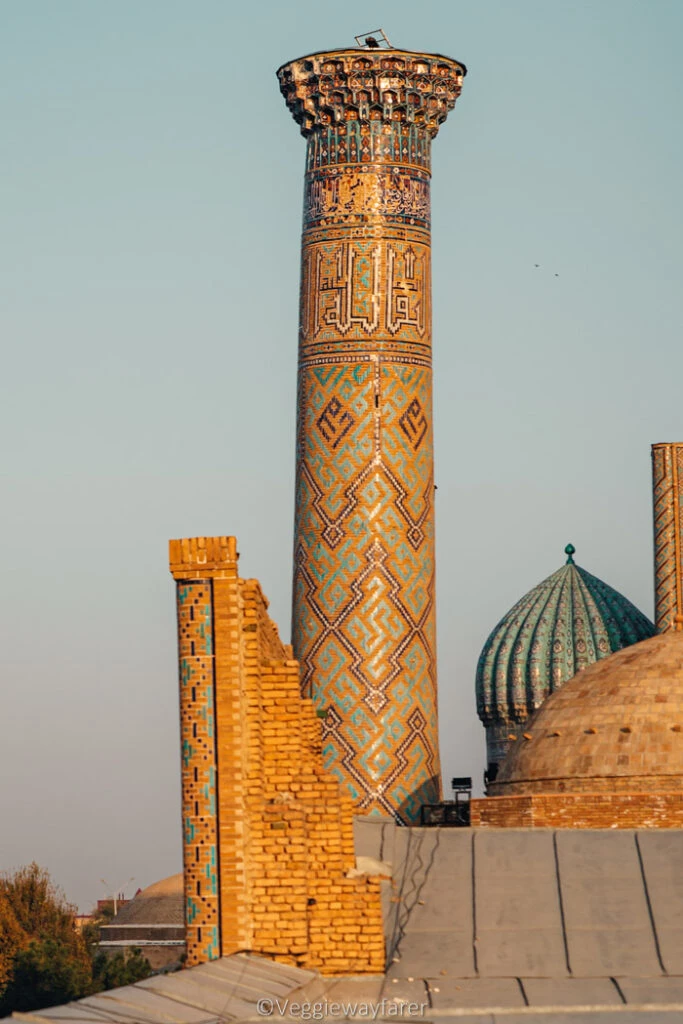

Bribe a guard and climb the Minaret overlooking Registan
Remember when I told you to go to the second floor on the Ulugh Beg madrasah and have a cup of tea. There is more to this story than meets the eye. This particular madrasah has another level and a Minaret you can climb, provided you give the local guard a small fee (110,000 UZS or $10 per visit, not per person).
We went in the early morning before any tourists were around and one of the early-bird vendors approached us asking if we wanted to climb the Minaret for a small fee. After we paid (cash), we were led to the staircase leading to the upper floor (the same one that leads you to the tea store), through some slightly dodgy-looking little corridors and narrow staircases, and up to the roof of the Madrasah.
The views from the roof were absolutely stunning. The next part up the minaret entailed a very small and narrow staircase up to a minuscule observation deck. As I suffer from vertigo, I opted to stay on the rooftop and watch the sunrise from here (breathtaking!). The girls came back down and were suitably in awe of the views from the Minaret.
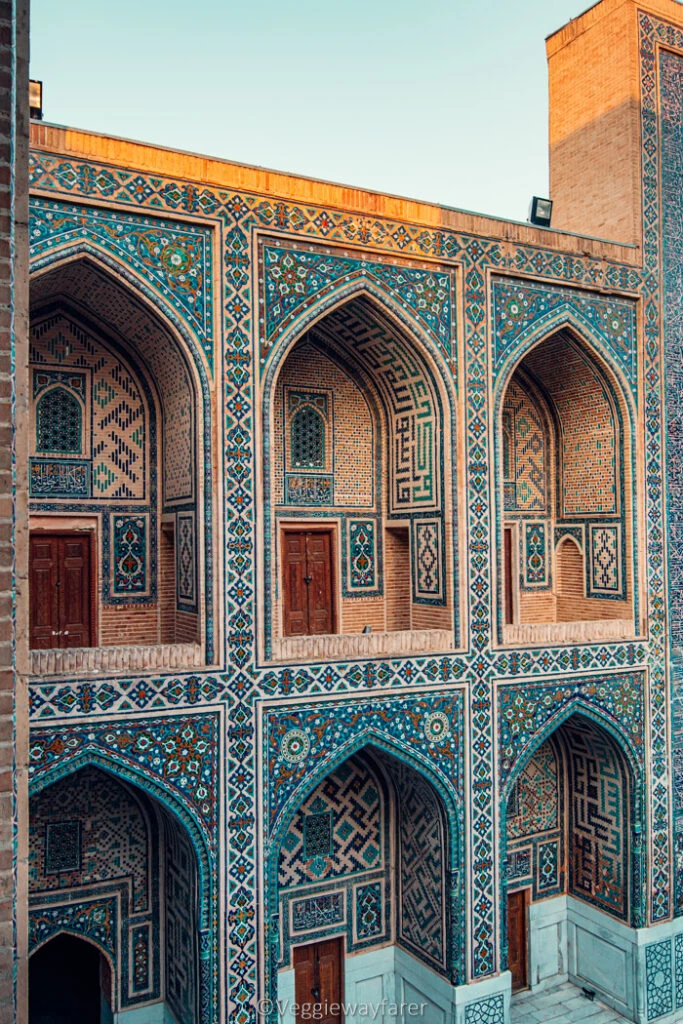

Learn about the history of the Islam School in the little shops (Ulugh Beg Madrasah)
The Ulugh Beg Madrasah really is the top Samarkand sight to visit, aside from the Madrasah, the tea shop, and the possibility to climb its Minaret it holds one additional secret.
As I mentioned before, the Madrasah once held the double function of dorm and classroom for the many students of Islam. The many small alcoves that today are filled with small stores were in fact those very dorms, and remnants of their former inhabitants are still present in the shape of frescoes, furniture, and pictures.
Local vendors are proud of their history and genuinely well-intentioned when they ask you to come in and take a look. We spent a good 10 minutes listening as the store owner explained the history behind the various elements. This is not a tourist trap, no fee is charged to tourists by the local vendors for this service. Purchasing a small souvenir is of course always welcomed.
Where to stay in Samarkand
Most of your time will be spent in and around old Samarkand, therefore, I highly suggest you choose a hotel in this part of town. Have a browse through these locally run hotels & guesthouses.
BEST LOCATION: Hotel Minor
Hotel Minor is located right off Registan Square and in fact, has a terrace overlooking the complex. The standard facilities are available including a restaurant, 24-hour reception, and wifi but also a shared kitchen and a shuttle service.
VALUE FOR MONEY: Hotel Rahmon
A beautiful green Oasis with abundant vines, trees and outside balconies. Guests particularly love the hospitality of the owners, the abundant breakfast and the great location close to the main tourist attractions.
BEST VIEWS: Bibikhanum Hotel
The hotel with a restaurant practically in the backyard of the Bibi Khanum Mosque. Rooms have a patio or garden view, flat-screen TV, and air conditioning. Additional services include a 24-hour reception and a continental breakfast upon request.
Map of Samarkand attractions
Click on this interactive Google Map containing the top things to do in Samarkand (red pins), the Samarkand train station (purple pin), and the various accommodations in Samarkand recommended in this guide (yellow pins).
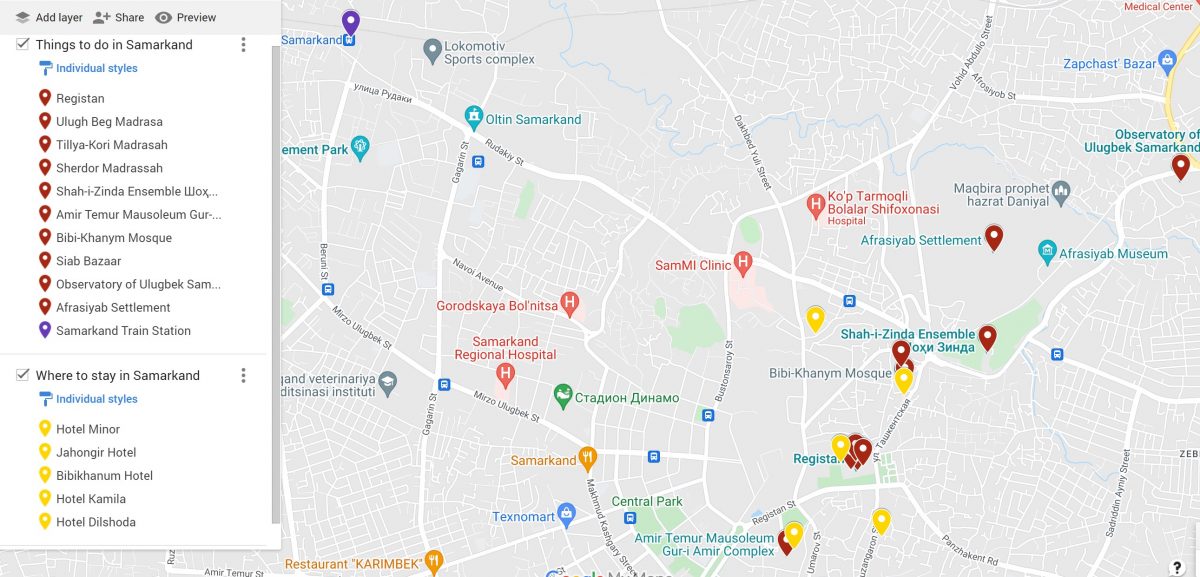
Vegetarian food in Samarkand
Traditional Uzbekistan cuisine is a true testimony to the historical significance Uzbekistan had on the Silk Route. The cuisine is an interesting mix of Persian, Indian, Mongolian, and Turik traditional dishes. An additional influence is the large planes of wheat and grain typical of the Uzbek countryside.
This translates into a fragrant cuisine, using plenty of delicious spices. Uzbekistan food is traditionally not spicy and relies heavily on meats, rice, noodles, and bread. It is not uncommon to be presented with shashlik (meat skewer), a sprinkling of vegetables, and a big portion of fragrant rice.
As a vegetarian in Uzbekistan, I have to admit I had a bit of a hard time. These were the staples I stuck to:
- MANTI: Dumplings stuffed with pumpkin (be sure to double-check there is no meat)
- NON: Traditional Uzbek bread
- LENTIL SOUP: Not always available in the summer months
- SALADS: Found as side dishes, usually smaller in size so order two or three dishes

How to get to Samarkand, Uzbekistan
The easiest and most sustainable way to get to Samarkand is by taking the train. Trains run on time, are clean, and a super safe way to travel around Uzbekistan. Plus they are great for cultural immersion (especially if you decide to travel 3e class on a night train). Samarkand is served by two types of trains fast (Afrosiyob) and slower soviet trains.
Tashkent to Samarkand
The easiest and fastest way to get to Samarkand is to hop on the Afrosiyob train which gets you to Samarkand in 2 hours. The slower train ride takes upwards of 4 hours. Trains run daily, multiple times a day with (one-way) ticket prices ranging between 75,000 UZS ($6.6) and 220,000 UZS ($20). Check time table and prices online.
We ended up taking the Afrosiyob and were pleasantly surprised by how modern the train was (compared to the sleeper soviet trains we had taken to Khiva and Bukhara).
Bukhara to Samarkand
Hop on a train from Bukhara to Samarkand. The Afrosiyob train will get you there in under 2 hours, while the slower train takes around 3.5 hours to reach Samarkand. One-way ticket prices start at 70,000 UZS ($7) and go up to 170,000 ($15). Check time table and prices online.
Somehow we ended up on the slow train between Bukhara and Samarkand. Which, truth be told was a great experience too, the journey was very relaxed and it allowed us to make a few new local friends.
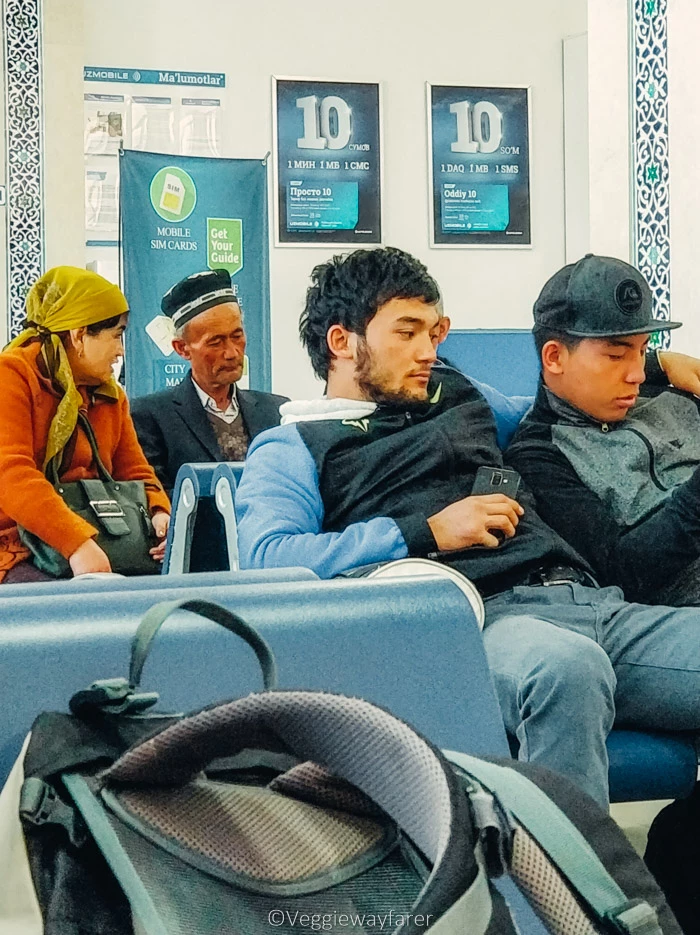

Practical information for taking the train to Samarkand
Where to purchase tickets
Train tickets in Uzbekistan are significantly cheaper when bought at the train station vs. online. The ticket office in Uzbek train stations is usually a separate building right off the main train station. When in doubt, ask one of the local guards in the train station who will happily point you in the right direction.
Do the attendants at the station speak English?
Yes, or rather enough to help you purchase your ticket. What I found helped was to check the timetable for trains in advance online and to write down the time and date I wanted to go to my specific location.
What to bring:
Passport and cash to pay for your ticket
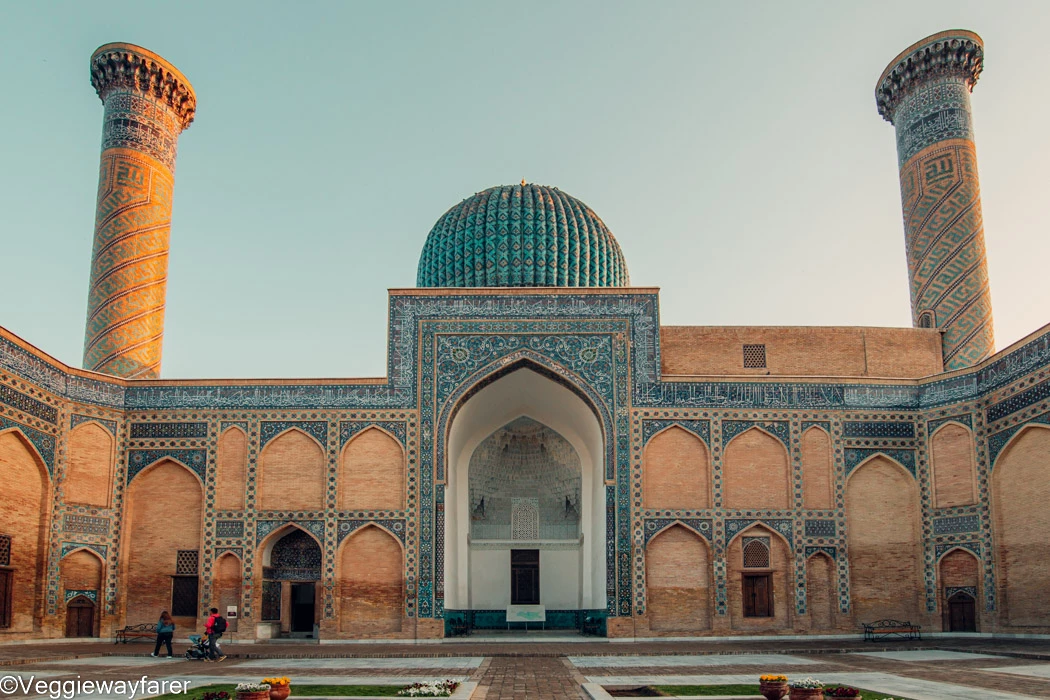
Samarkand Travel – Budget Split
Good news, your Samarkand holidays are not going to break the bank. In fact, Uzbekistan in general is a very budget-friendly destination.
HOTELS: Guesthouses start at $25/night while a more upscale hotel can go up to $80/night
RESTAURANTS: We paid between $6-$10 for a meal
ENTRANCE TICKETS: $25
TRANSPORTATION (train & taxi): $10
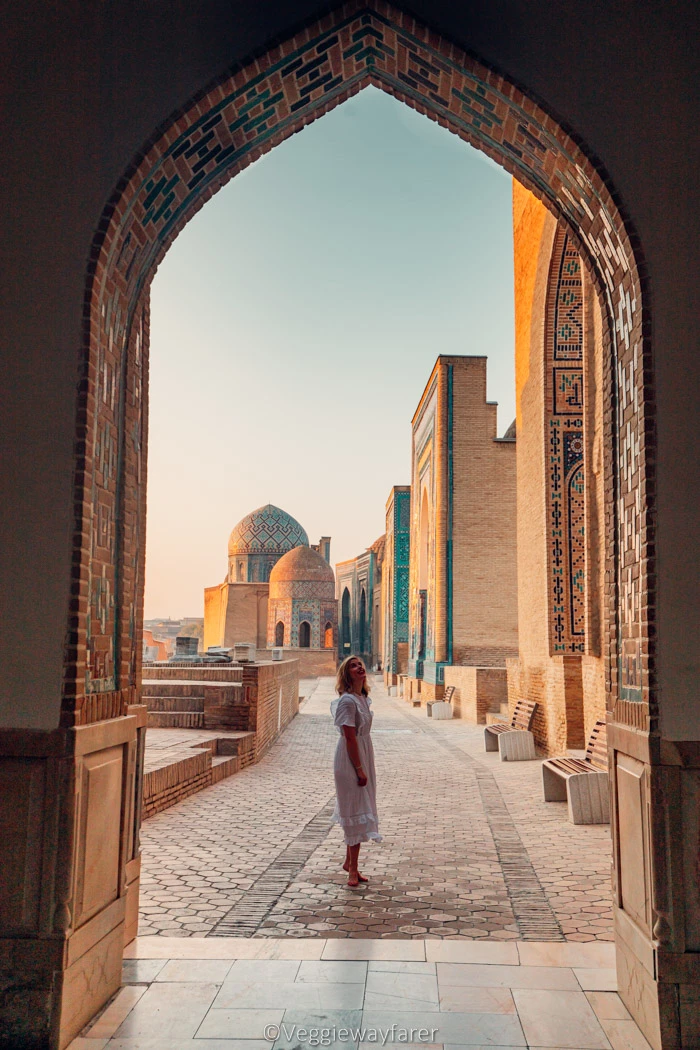

Travel Tips for Visiting Samarkand
A few last tidbits of information before sending you off on your journey to Samarkand and other parts of beautiful Uzbekistan.
What to pack for Samarkand
While there is no strict dress code to adhere to in Uzbekistan, some of the places to visit in Samarkand are places of worship (Shah-i-Zindah, Gur-e-Amir Mausoleum) and ask visitors to wear modest clothing. For women, this mainly entails covering knees and shoulders (can be done with a simple scarf).
Aside from this, exploring Samarkand involves a fair amount of walking. A pair of comfortable shoes or sandals are an absolute must.
Is Samarkand Uzbekistan safe?
Yes. My 2 fellow female companions and I traveled all over Uzbekistan taking local trains and taxis, sleeping in budget guesthouses, and eating in small locally run restaurants. We explored the Samarkand sights both during the day and at night and felt perfectly safe.
Personally, I felt a little less safe in Tashkent and had the impression locals were a little less hospitable than in other parts of the country. But aside from that, I would say Uzbekistan is a lot safer than my hometown Brussels.
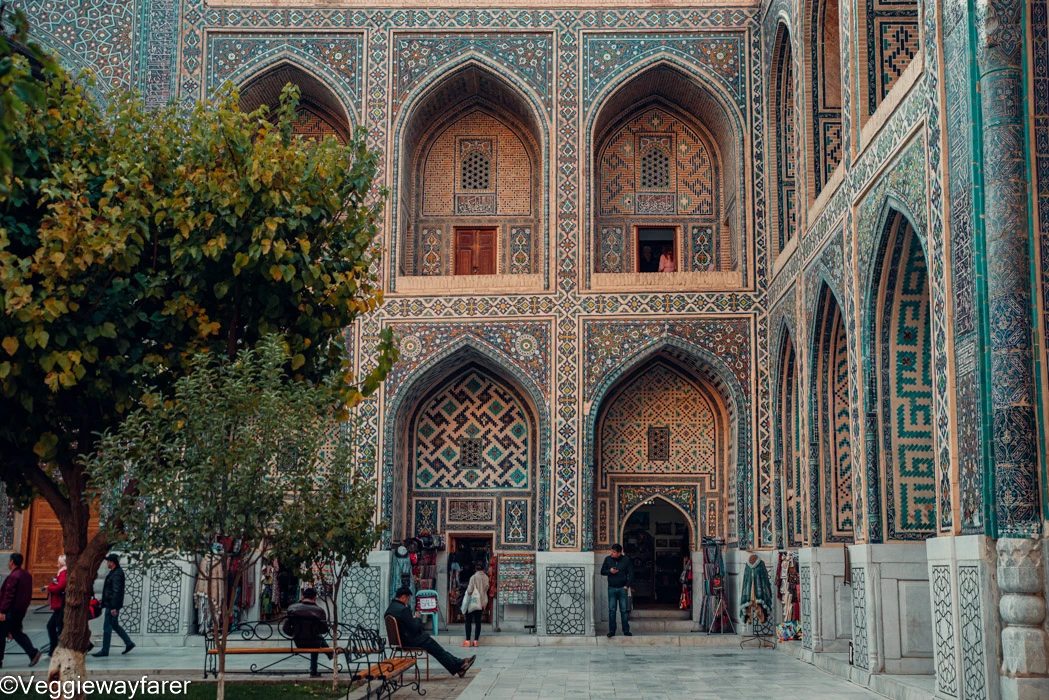
Things to do in Samarkand Uzbekistan Conclusion
Traveling to Samarkand was the highlight of my trip to Uzbekistan, this UNESCO classified city is a must on any Uzbekistan itinerary. The grandeur and opulence of Registan and the beautifully preserved Shah-i-Zinda are hard to beat. Aim to spend two full days and add on an extra day to squeeze in a day trip to Shakhrisabz.
ADDITIONAL RESOURCES FOR TRAVEL IN ASIA
UZBEKISTAN: Guide to two days in Bukhara
IRAN: Things to do in Shiraz, Iran

Samarkand Travel Guide: Pin it
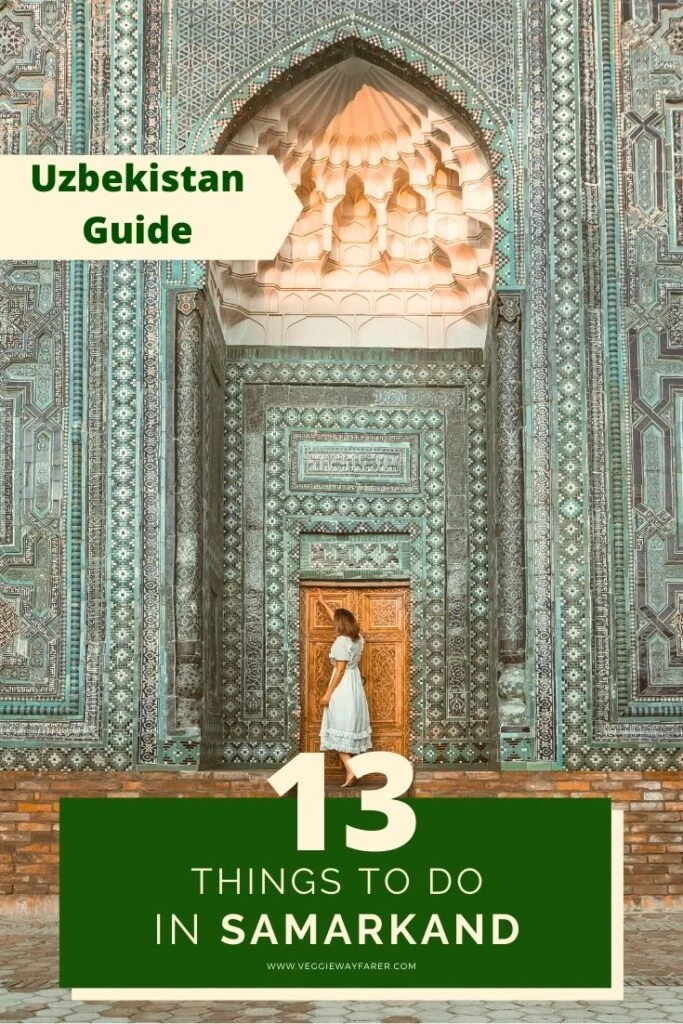


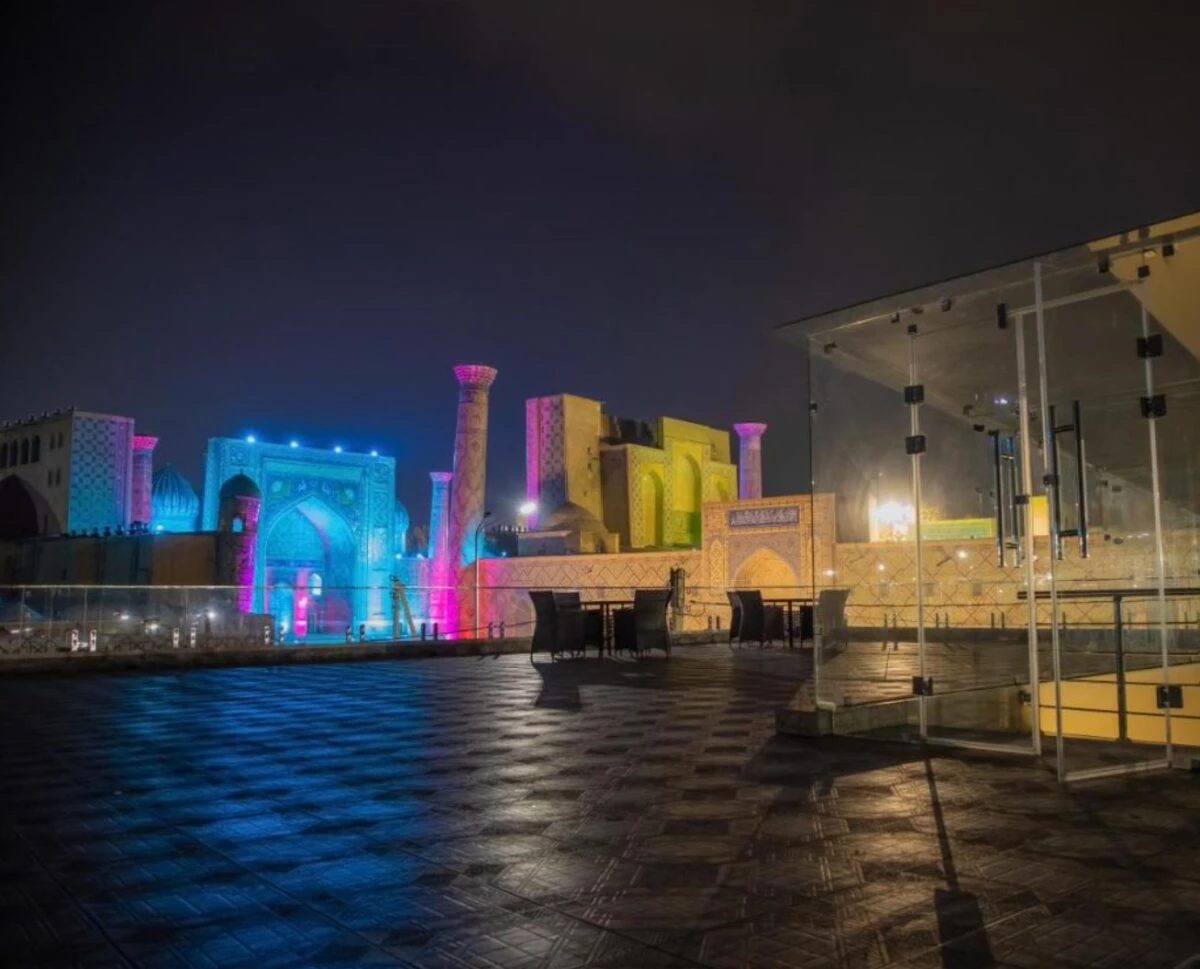
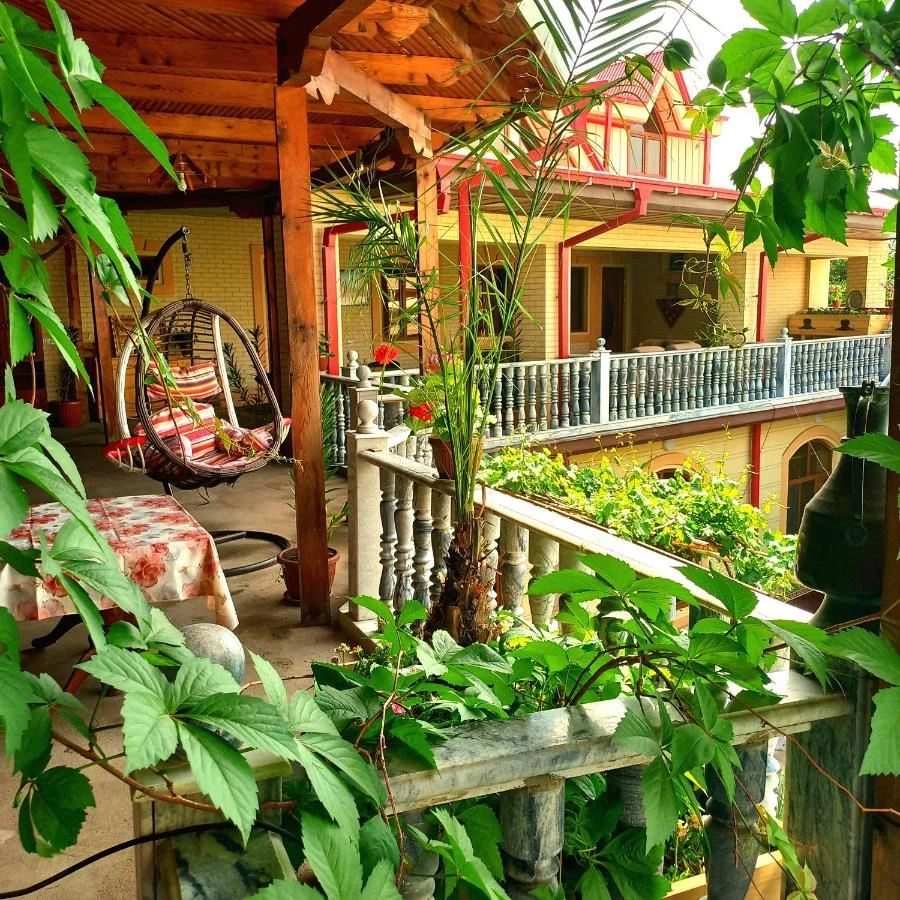
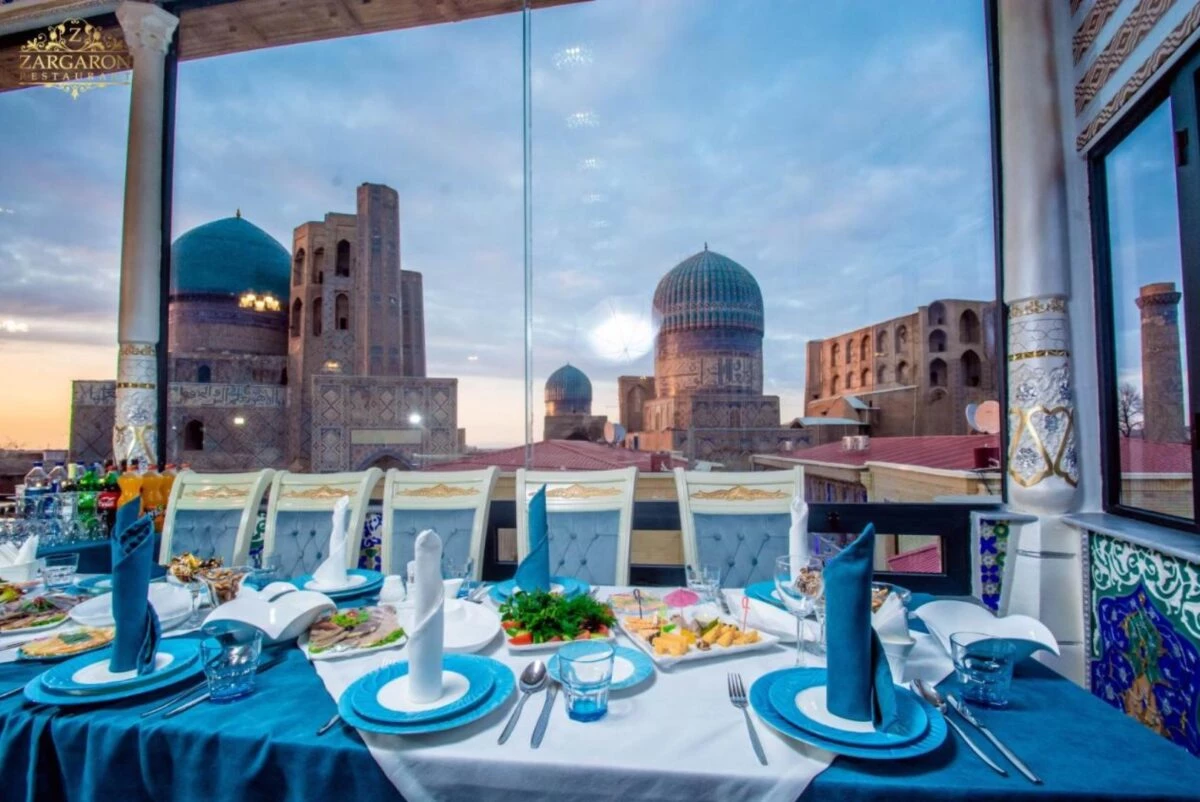
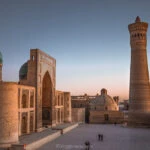



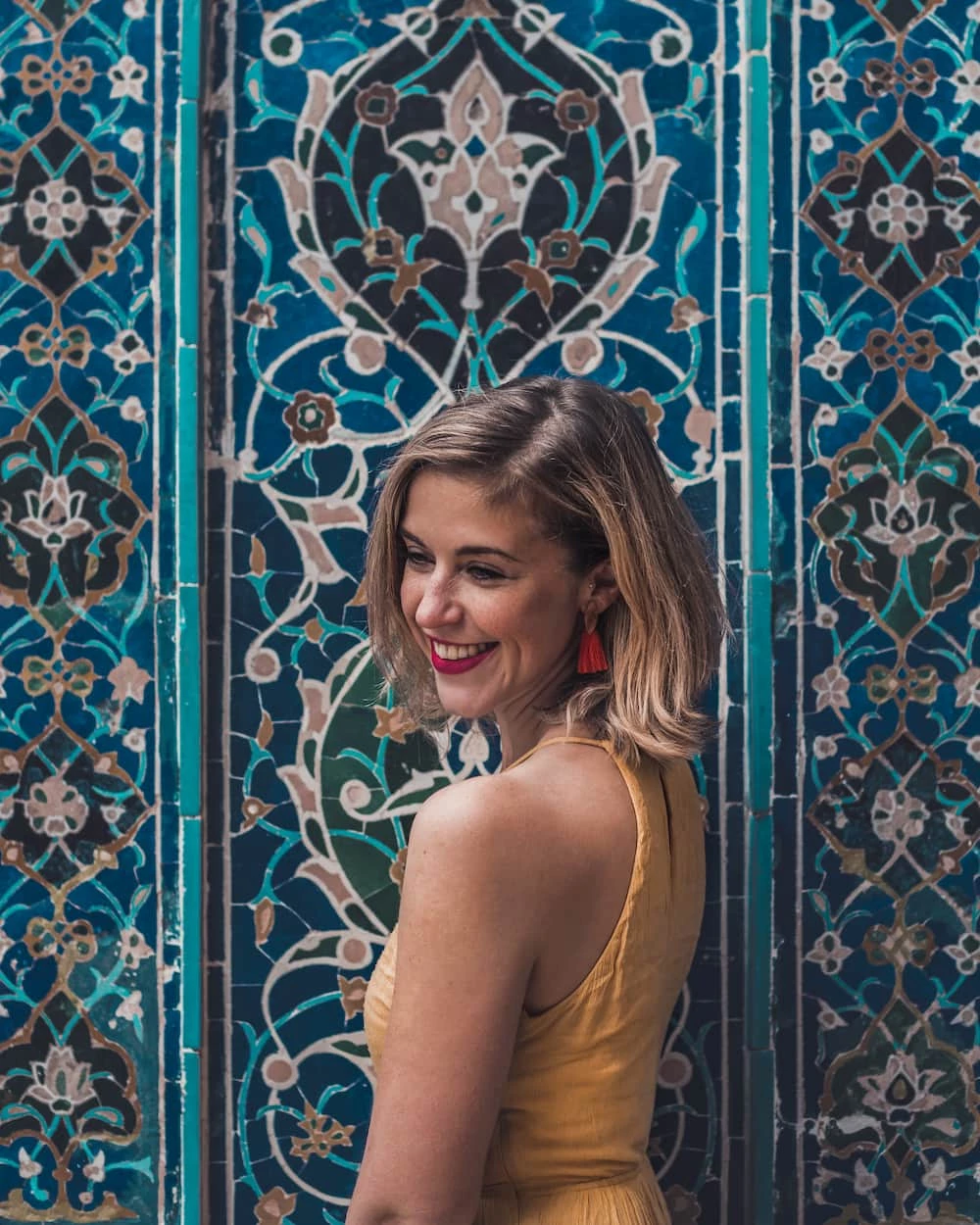

0 Comments